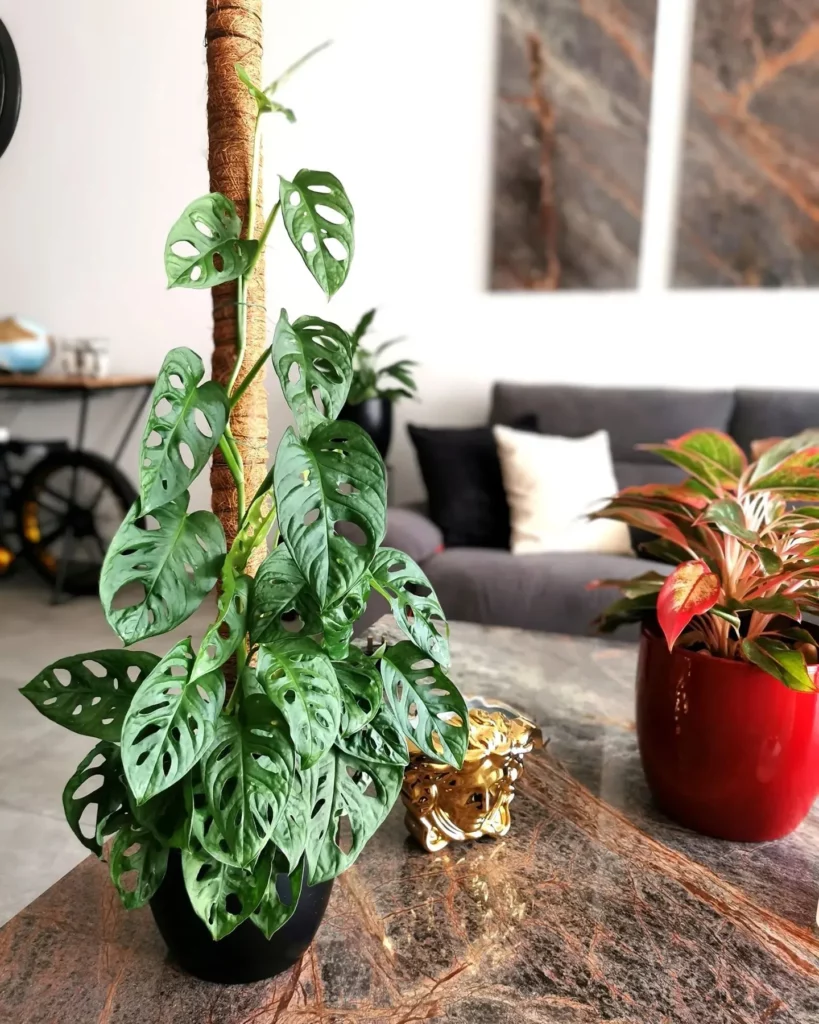The Monstera deliciosa, also known as the Swiss Cheese Plant, is a tropical perennial that is typically grown as an indoor plant. It is native to Central and South America and is named for its large, heart-shaped leaves that develop holes as the plant ages. This plant has a fast growth rate and a vining habit, but it can be kept at a manageable size when grown in a container indoors.
Key Takeaways:
- Monstera deliciosa, also known as the Swiss Cheese Plant, is a tropical perennial with large, heart-shaped leaves that develop holes.
- It is typically grown as an indoor plant, but can also thrive outdoors in warmer climates.
- Monstera deliciosa has a fast growth rate and a vining habit, but can be kept at a manageable size indoors.
- It prefers bright, indirect light and should be protected from direct sunlight to prevent leaf burn.
Appearance of Monstera Deliciosa


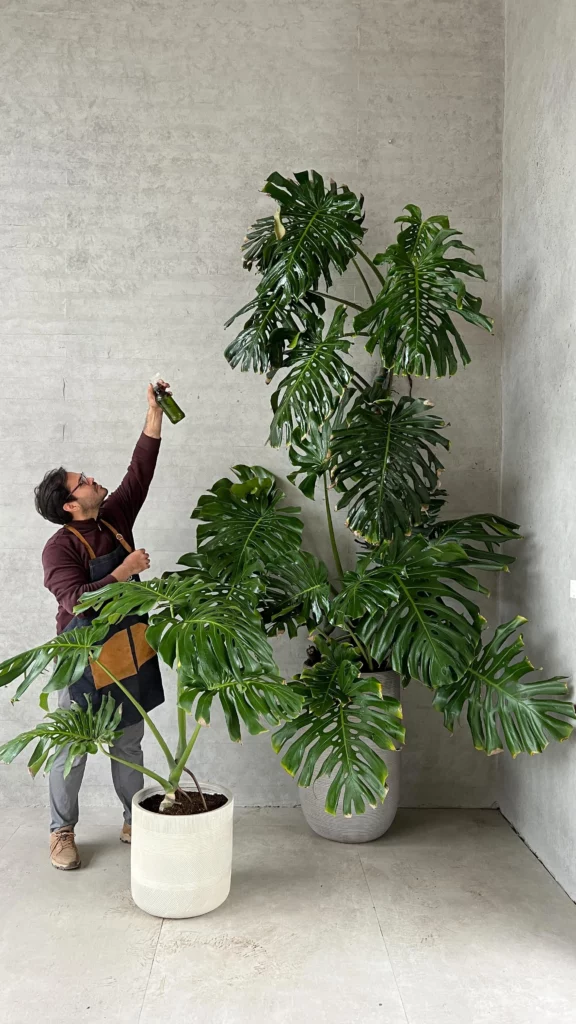
The Monstera deliciosa is known for its stunning and unique appearance. Its large, heart-shaped leaves are a distinguishing feature of this plant. These leaves can grow up to three feet wide and have a lush, green color that adds a vibrant touch to any space.
But what truly sets the Monstera deliciosa apart is the development of holes in its leaves as it matures, giving it a Swiss cheese-like appearance. These holes, also known as fenestrations, start as small slits and gradually expand over time, creating a striking pattern on the leaves.
The Monstera deliciosa can reach impressive sizes, both indoors and outdoors. When grown in its natural habitat, it can reach heights of 10-13 feet, while indoor specimens typically range from 3-8 feet in height.
This plant has a vining habit, so it can be trained to climb with the help of a stake or trellis, adding an interesting vertical element to your space. Whether you choose to let it trail gracefully or guide it upwards, the Monstera deliciosa’s lush foliage and unique leaf patterns make it a beautiful addition to any home or garden.
Key Points:
- The Monstera deliciosa has large, heart-shaped leaves that can grow up to three feet wide.
- The leaves develop holes, known as fenestrations, as the plant matures, giving it a Swiss cheese-like appearance.
- The plant can reach heights of 10-13 feet outdoors and 3-8 feet indoors and has a vining habit that can be trained to climb with support.
No products found.
Light Requirements for Monstera deliciosa



To keep your Monstera deliciosa happy and thriving, it is important to provide it with the right amount of light. This tropical plant prefers bright, indirect light, similar to the conditions it experiences under the cover of large trees in its natural habitat. Direct sunlight can be too intense and may cause leaf burn, so it’s best to avoid placing your Monstera deliciosa in direct sunlight for extended periods.
When it comes to light exposure, morning sun is ideal for your Monstera deliciosa. If direct sunlight is unavoidable, limit it to just two or three hours a day. This will help prevent any potential damage to the leaves. It’s important to note that if your Monstera deliciosa is kept in low light conditions, the distinctive holes that develop on the leaves may not fully develop.
Here are some tips for providing the right light conditions for your Monstera deliciosa:
- Place your plant near a north or east-facing window to provide bright, indirect light.
- Avoid placing your Monstera deliciosa in direct sunlight, especially during the hottest parts of the day.
- If you don’t have access to enough natural light, you can supplement it with artificial grow lights.
- Monitor your plant’s response to light exposure and adjust its placement accordingly.
Watering Monstera deliciosa
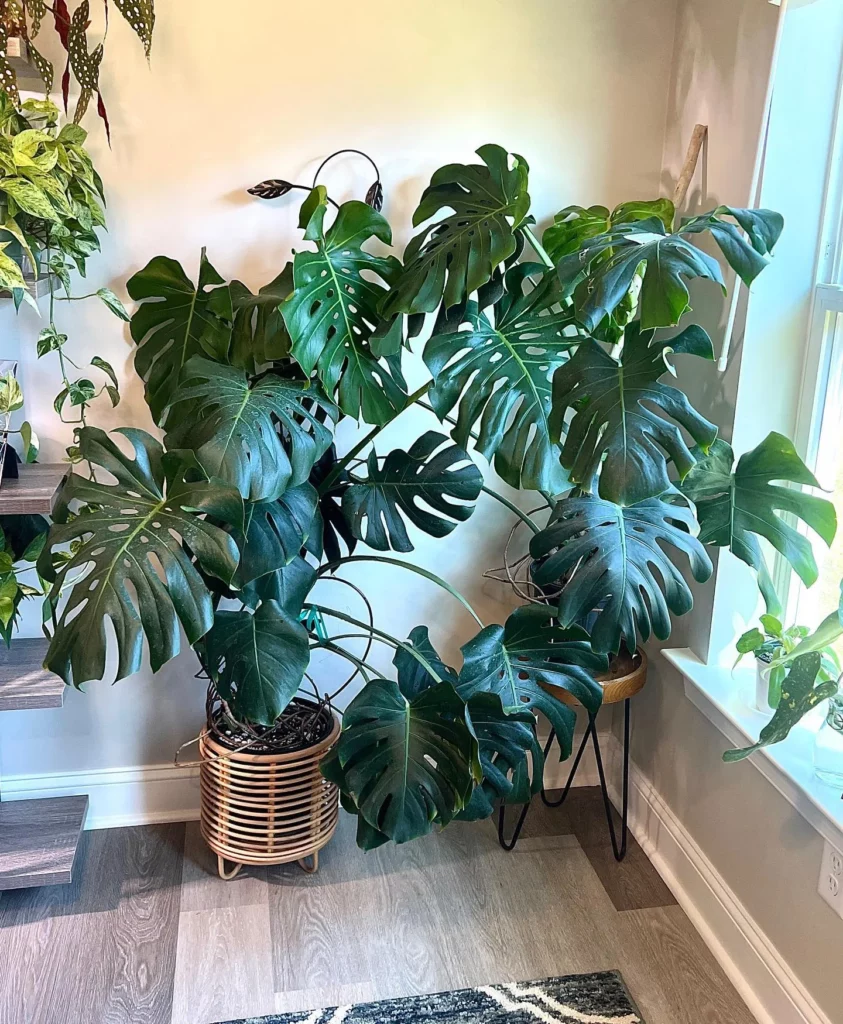


To keep your Monstera deliciosa happy and healthy, it’s essential to provide it with the right amount of water. Proper watering is crucial as both overwatering and underwatering can harm the plant. Here are some guidelines to help you water your Monstera deliciosa effectively:
- Check the soil moisture: Before watering your plant, it’s important to check the soil moisture. Stick your finger about an inch deep into the soil. If it feels dry at this depth, it’s time to water the plant. If it’s still moist, wait a few more days before watering.
- Water thoroughly: When watering, make sure to water the plant until water starts to trickle out of the drainage holes in the container. This ensures that the entire root ball gets hydrated. Avoid letting the plant sit in standing water as it can lead to root rot.
- Observe the drainage: Monstera deliciosa prefers well-draining soil. If the water doesn’t drain properly and instead puddles on the surface, it may indicate that the soil mix is too dense and needs to be amended with perlite or orchid bark.
- Establish a watering schedule: Monstera deliciosa likes to be consistently moist but not soaked. It’s best to develop a watering schedule based on your specific climate, the humidity levels in your home, and the rate at which the soil dries out. As a general rule, water your Monstera deliciosa about once a week in warmer months and adjust frequency accordingly in cooler months.
Fertilizing Monstera deliciosa
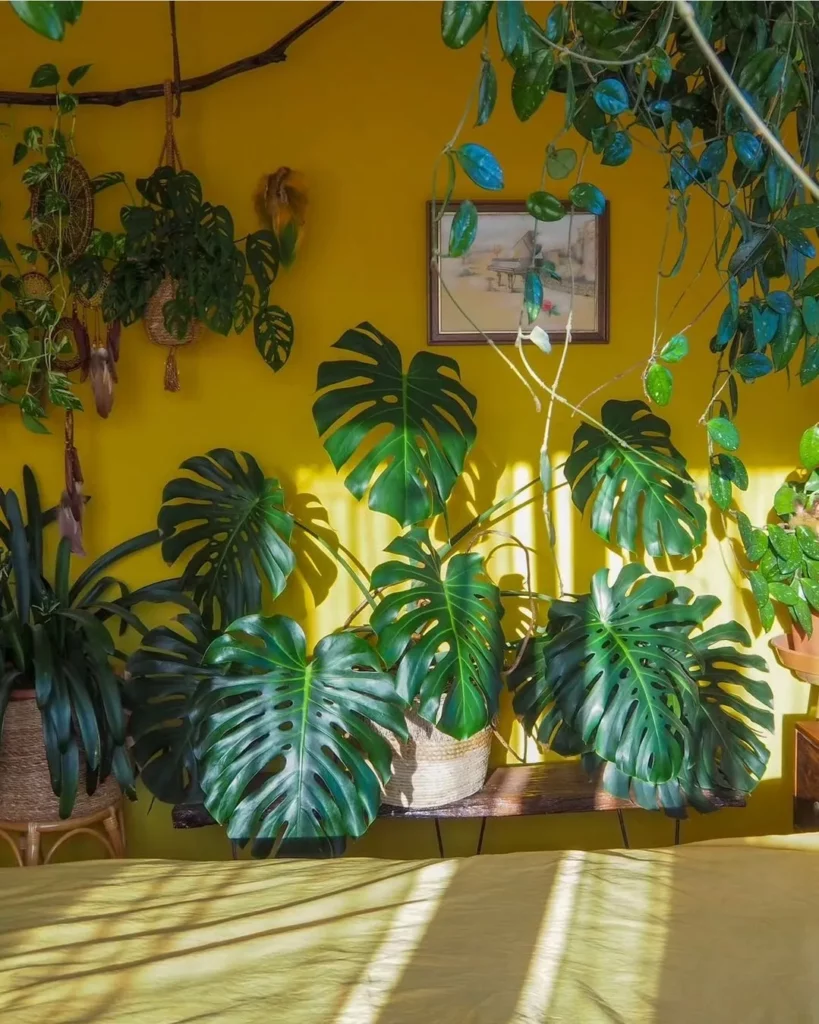
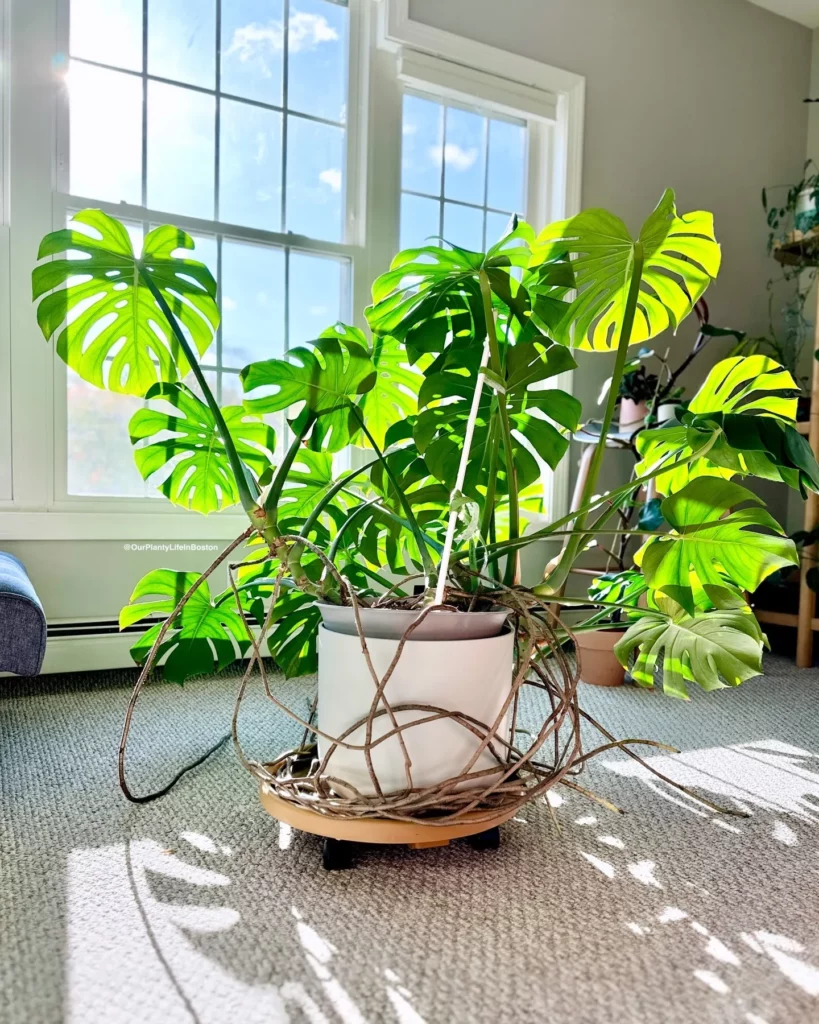

Fertilizing your Monstera deliciosa is an essential part of its care routine. Providing the right nutrients will help promote healthy growth and vibrant foliage. Here are some key points to keep in mind when fertilizing your Swiss Cheese Plant:
- Choose a balanced fertilizer: Look for a fertilizer specifically formulated for houseplants with an N-P-K ratio of 5-2-3. This balanced blend of nitrogen (N), phosphorus (P), and potassium (K) will provide your Monstera deliciosa with the necessary nutrients for optimal growth and development.
- Follow a regular fertilizing schedule: During the growing season, which typically runs from March to September, fertilize your Monstera deliciosa once a month. Dilute the fertilizer according to the manufacturer’s instructions and apply it to the soil around the base of the plant.
- Avoid fertilizing newly potted plants: If you recently repotted your Monstera deliciosa, wait at least four to six months before applying fertilizer. The potting mix usually contains slow-release nutrients that will sustain the plant during this initial period.
- Monitor your plant’s response: Keep an eye on your Monstera deliciosa after fertilizing. If you notice any signs of overfertilization, such as burnt leaf tips or yellowing foliage, reduce the amount or frequency of fertilization. Conversely, if your plant appears pale or lacks vigor, you may need to increase the amount of fertilizer or switch to a more potent formula.
Nutrient Needs of Monstera deliciosa
Monstera deliciosa has moderate nutrient requirements to support its growth and foliage development. The main nutrients it needs include:
- Nitrogen (N): Nitrogen is essential for leaf growth and overall plant vigor. It helps to promote lush, green foliage in your Monstera deliciosa.
- Phosphorus (P): Phosphorus aids in root development and flower production. It plays a crucial role in supporting the plant’s energy transfer processes.
- Potassium (K): Potassium is necessary for overall plant health and disease resistance. It helps regulate water uptake and enables the efficient utilization of nutrients.
While Monstera deliciosa can obtain some nutrients from the surrounding environment, supplementing its diet with a balanced fertilizer will ensure it receives an adequate supply of these essential elements. Regular fertilization will promote vigorous growth and help your plant thrive in its indoor environment.
Potting Monstera Deliciosa
When it comes to potting your Monstera deliciosa, choosing the right container and potting mix is essential. This plant thrives in peat-based potting mixes that provide adequate moisture retention without becoming waterlogged.
Select a container that is slightly larger than the plant’s root ball to allow for future growth. It’s important to position the plant at the same depth as it was in its nursery container. This will provide stability and prevent stem rot.
Repotting should be done every two years or when the roots start to poke through the drainage holes or the soil dries out quickly. Spring is the ideal time for potting or repotting your Monstera deliciosa. During this time, the plant is actively growing and can quickly establish itself in its new home. Be sure to gently loosen the roots when repotting to encourage healthy growth.
When potting or repotting your Monstera deliciosa, be mindful of its size. This plant has the potential to grow quite large, so choose a container that allows for adequate space for its growth.
Providing support, such as a moss pole or trellis, can also help guide the plant’s growth and maintain its shape. Regularly check the moisture levels in the soil and adjust your watering routine accordingly. Remember, it’s better to underwater than overwater your Monstera deliciosa.
Potting Monstera Deliciosa: Key Points
- Choose a peat-based potting mix that retains moisture without becoming waterlogged
- Select a slightly larger container to accommodate growth
- Position the plant at the same depth as its nursery container
- Repot every two years or when roots poke through drainage holes
- Loosen roots gently when repotting
- Provide support for the plant’s growth, such as a moss pole or trellis
- Check soil moisture regularly and adjust watering accordingly
Propagation of Monstera Deliciosa
Propagating Monstera deliciosa is an exciting way to grow new plants and expand your collection. There are two common methods for propagating this tropical beauty: stem cuttings and air layering.
Stem Cuttings
Stem cuttings are a popular and straightforward way to propagate Monstera deliciosa.
- To begin, select a healthy stem with at least one leaf node.
- Using clean pruning shears, make a diagonal cut just below a leaf node.
- The cutting should be around 4-6 inches long.
- Next, prepare a small container filled with moistened soilless potting mix.
- Make a hole in the soil and insert the cutting, ensuring that at least one node is buried in the soil.
- You can also dip the cut end of the stem in a rooting hormone powder before planting to encourage root growth.
- Place the container in a warm and bright location, avoiding direct sunlight.
- Mist the cutting regularly to maintain humidity and prevent the soil from drying out.
- Within a few weeks to a couple of months, you should start to see roots forming. Once the roots are well-established, you can transplant the new plant into a larger pot filled with a suitable potting mix.
Air Layering
Air layering is another method that can be used to propagate Monstera deliciosa. This technique involves creating a root system on a section of the stem while it is still attached to the parent plant.
To air layer a Monstera deliciosa, select a healthy stem and make a small incision through the outer bark. Apply a rooting hormone to the exposed area, if desired. Next, wrap the area with moist sphagnum moss and cover it with a plastic wrap or a plastic bag to maintain humidity.
Over time, roots will develop from the stem within the moss. Once the roots are well-developed, you can carefully cut below the rooted section and pot it in a suitable growing medium. This method can take several weeks to months, but it can be a rewarding way to propagate Monstera deliciosa without removing any cuttings from the parent plant.
Growth and Development of Monstera deliciosa
The Monstera deliciosa is known for its rapid growth, making it an exciting addition to any indoor or outdoor space. This plant has a fast growth rate and can add 1-2 feet to its height each year, especially when provided with optimal conditions such as bright, indirect light. With its vining habit, the Monstera deliciosa can quickly climb and reach impressive heights, sometimes up to 70 feet in outdoor settings.
As the Monstera deliciosa matures, its large, heart-shaped leaves develop the iconic holes that give it the Swiss cheese-like appearance. These holes are a natural part of the plant’s growth and add to its unique charm. However, it’s important to note that younger plants may not initially display these holes and they typically develop as the plant ages.
To support the growth of the Monstera deliciosa, it’s essential to provide adequate space and support as needed. With its vining habit, the plant can benefit from stakes or trellises to encourage upward growth. Pruning can also help maintain the desired size and shape of the plant, preventing it from becoming too large or unruly.
Growth and Development Recap:
- The Monstera deliciosa has a fast growth rate, adding 1-2 feet to its height each year.
- As the plant matures, its large leaves develop distinctive holes, adding to its unique appearance.
- Provide adequate space and support, such as stakes or trellises, to encourage upward growth.
- Pruning can help maintain the desired size and shape of the plant.
Pests and Diseases of Monstera deliciosa
While the Monstera deliciosa is a beautiful plant to have in your home, it is not immune to the presence of pests and the risk of diseases. Being aware of the common issues that may arise can help you take prompt action and ensure the health and vitality of your plant.
Pests:
- Mealybugs: These small, cottony insects can infest the leaves and stems of your Monstera deliciosa. To treat them, wipe the affected areas with a cotton swab dipped in rubbing alcohol or use insecticidal soap.
- Spider Mites: Look out for webbing and tiny red or brown mites on your plant. Regularly misting the leaves and using insecticidal soap can help control the infestation.
- Scale Insects: These pests appear as small, immobile bumps on the plant’s stems and leaves. You can remove them manually with a cotton swab dipped in alcohol or use insecticidal soap.
- Whiteflies: These tiny, white insects can be found on the undersides of leaves. Use yellow sticky traps or insecticidal soap to control their population.
Diseases and Common Issues:
- Root Rot: Overwatering or poorly draining soil can lead to root rot. To prevent this, ensure proper drainage and only water when the top inch of soil feels dry to the touch.
- Rust: Rust-colored spots on the leaves may indicate a fungal infection. Remove the affected leaves and improve air circulation around the plant.
- Powdery Mildew: A white, powdery substance on the leaves is a sign of powdery mildew. Remove the affected leaves and use a fungicidal spray to control the spread.
- Blight: Blight causes dark, water-soaked spots on the leaves. Remove the affected leaves and avoid overhead watering to prevent the spread of the disease.
Different Varieties of Swiss Cheese Plants
The term “Swiss cheese plant” encompasses a variety of species within the Monstera genus. While Monstera deliciosa is the most well-known and commonly grown variety, there are several others that offer unique characteristics and appearances. Here are some of the different Swiss cheese plant varieties:
- Monstera adansonii: This variety has smaller leaves compared to Monstera deliciosa and features distinctive holes, giving it a delicate and intricate look.
- Monstera obliqua: Known for its extremely holey leaves, Monstera obliqua has a more delicate appearance and requires precise care to thrive.
- Monstera dubia: This variety stands out with its variegated leaves, featuring patterns and streaks of different shades of green.
- Monstera siltepecana: With its lance-shaped leaves and silvery variegation, Monstera siltepecana adds a touch of elegance to any indoor space.
- Monstera standleayana: Characterized by long and slender leaves with dramatic coloring, Monstera standleayana is a captivating variety to grow.
Pruning Monstera deliciosa
If you want to maintain the size and shape of your Monstera deliciosa plant, pruning is an essential step in your maintenance routine. Pruning helps control the growth and prevents the plant from becoming too large or unruly. Spring is the ideal time to prune your Monstera deliciosa, using sterile pruning shears to ensure a clean cut.
To begin, identify the stems that need to be pruned. You can cut back stems by no more than 25 percent, right above a leaf node. This will encourage new growth and maintain the overall shape of the plant. If you notice any dead or damaged leaves, it’s a good idea to remove them as well, as this will promote healthier growth.
Pruning not only helps control the size of your Monstera deliciosa but also encourages bushier growth. By selectively pruning stems, you can create a fuller and more attractive appearance. Remember to always use clean, sharp pruning tools to prevent the spread of diseases. Regular pruning will keep your Monstera deliciosa looking its best and ensure its long-term health and beauty.
Pruning Tips for Monstera deliciosa:
- Prune in the spring using sterile pruning shears
- Cut back stems by no more than 25 percent, right above a leaf node
- Remove dead or damaged leaves to promote healthier growth
- Pruning encourages bushier growth and a fuller appearance
- Use clean, sharp pruning tools to prevent the spread of diseases
Safety Precautions for Monstera deliciosa
When growing the Monstera deliciosa plant, it is important to keep safety in mind, especially if you have pets or small children in your household. This plant is toxic to both humans and animals if ingested, so it’s essential to take precautionary measures to prevent any harm.
Symptoms of Monstera deliciosa ingestion may include mouth, lip, and tongue irritation, drooling, vomiting, and difficulty swallowing. To ensure the safety of your loved ones, it is recommended to keep this plant out of reach. Place it in an elevated position or use hanging baskets to prevent curious pets or children from accessing it.
FAQ
How often should I water my Monstera deliciosa?
Monstera deliciosa likes to be consistently moist but not soaked. Check the soil moisture by sticking a finger into the soil about an inch deep. Water the plant when the soil feels nearly dry to the touch.
What kind of light does Monstera deliciosa need?
Monstera deliciosa prefers bright, indirect light. Morning sun is best, and direct sunlight should be limited to just two or three hours. In low light conditions, the distinctive holes may not develop on the leaves.
How often should I fertilize my Monstera deliciosa?
Fertilize your Monstera deliciosa every month during the growing season (March-September) using a balanced fertilizer with an N-P-K ratio of 5-2-3. Wait at least four to six months after potting a new plant before fertilizing.
When should I repot my Monstera deliciosa?
Repot your Monstera deliciosa every two years or when the roots start to poke through the drainage holes or the soil dries out quickly. Spring is the best time for potting and repotting.
How can I propagate my Monstera deliciosa?
Monstera deliciosa can be propagated through stem cuttings or air layering. For stem cuttings, trim a 4-6 inch piece of stem just after a leaf node and plant it in moistened soilless potting mix. For air layering, wrap a section of stem with sphagnum moss and wait for roots to develop.
How fast does Monstera deliciosa grow?
Monstera deliciosa is a fast-growing plant, especially in optimal conditions with indirect light. It can grow an average of 1-2 feet per year.
What pests and diseases should I watch out for with Monstera deliciosa?
Common pests that may affect Monstera deliciosa include mealybugs, spider mites, scale, and whitefly. Diseases such as root rot, rust, powdery mildew, and blight can also occur. Treat pests with nontoxic insecticides or neem oil, and address diseases accordingly.
Are all parts of Monstera deliciosa toxic?
Yes, all parts of the Monstera deliciosa plant are toxic to pets and humans if ingested. Keep this plant out of reach of pets and small children to prevent any potential harm.
How should I prune my Monstera deliciosa?
Pruning should be done in the spring using sterile pruning shears. Cut back stems by no more than 25 percent, right above a leaf node. Remove dead or damaged leaves as needed to maintain the desired appearance of the plant.
What are the different varieties of Swiss Cheese Plants?
The term “Swiss cheese plant” can refer to several different species, including Monstera deliciosa, Monstera adansonii, Monstera obliqua, Monstera dubia, Monstera siltepecana, and Monstera standleayana. Each variety has unique characteristics and appearances.
What safety precautions should I take with Monstera deliciosa?
All parts of the Monstera deliciosa plant are toxic to pets and humans if ingested. Keep this plant out of reach of curious pets and children to prevent any potential harm.


